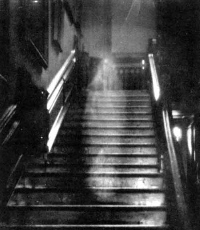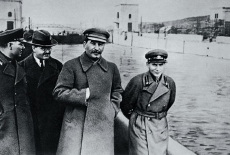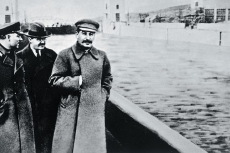 |  |
| HOME | FORUM | REGISTER | LOGIN | HOAXIPEDIA | TOP 100 APRIL FOOLS | COLLEGE PRANKS | ABOUT THE CURATOR |
| A HISTORY OF HOAXES | HOAX WEBSITES | HOAX PHOTO TESTS | GULLIBILITY TESTS | TALL-TALE CREATURES | CONTACT |
About the Hoax Photo Database
The Hoax Photo Database catalogs examples of photo fakery, from the beginnings of photography up to the present. Included in the database are photos that are "real," but which have been suspected of being fake, as well as images whose veracity remains undetermined. The photos are displayed in chronological order (or reverse-chronological). They're categorized by theme, technique of fakery (if known), and time period. See below for the full list of categories.
Other viewing options
View database as Thumbnail Gallery, reverse-chronological or chronological.
The Hoax Photo Database catalogs examples of photo fakery, from the beginnings of photography up to the present. Included in the database are photos that are "real," but which have been suspected of being fake, as well as images whose veracity remains undetermined. The photos are displayed in chronological order (or reverse-chronological). They're categorized by theme, technique of fakery (if known), and time period. See below for the full list of categories.
Other viewing options
View database as Thumbnail Gallery, reverse-chronological or chronological.
Techniques of Fakery
Numerous techniques of image manipulation are now available to photographers. Instead of trying to list every one, we've narrowed them down to a few broad categories.
Time Periods
Numerous techniques of image manipulation are now available to photographers. Instead of trying to list every one, we've narrowed them down to a few broad categories.
- Added Details
- Deleted Details
- False Caption
- Manipulating Existing Details
- Staged Scene
- Trick Angle
Time Periods
This page has been viewed 0 times.
Wisconsin’s Capitol Collapses
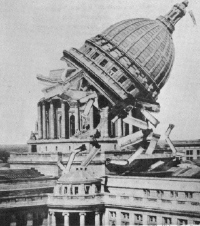
Status: April Fool's Day joke
Date: April 1, 1933
Date: April 1, 1933
The Madison Capital-Times ran this photo on its front page to accompany an article, in honor of April Fool's Day, about the dome of the Wisconsin state capitol supposedly collapsing because "large quantities of gas, generated through many weeks of verbose debate in the Senate and Assembly chambers, had in some way been ignited."
By modern standards the picture looks phony, but many readers in 1933 were fooled. One particularly irate reader wrote in declaring the hoax "was not only tactless and void of humor, but also a hideous jest."
By modern standards the picture looks phony, but many readers in 1933 were fooled. One particularly irate reader wrote in declaring the hoax "was not only tactless and void of humor, but also a hideous jest."
References:
April Fool's Day 1933, Hoaxipedia.
April Fool's Day 1933, Hoaxipedia.
Technique: Composite Images. Time Period: 1920-1939.
Themes: Architecture, Humor, April Fool’s Day, Politics,.
Themes: Architecture, Humor, April Fool’s Day, Politics,.
Baby Adolf
Status: Fake (altered in darkroom)
Date: Late 1933
Date: Late 1933
In 1933, a picture supposedly showing Adolf Hitler as a baby began circulating throughout England and America. The child in the picture looked positively menacing. Its fat mouth was twisted into a sneer, and it scowled at the camera from dark, squinted eyes. A greasy mop of hair fell over its forehead.
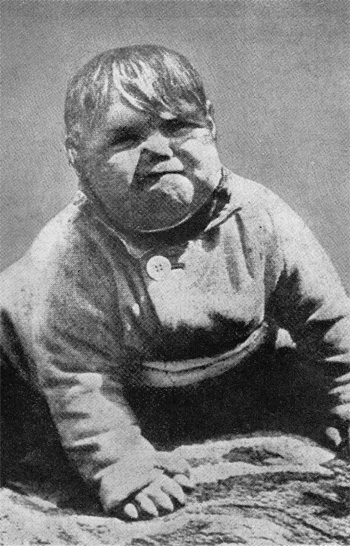
The image was distributed by Acme Newspictures, Inc. and appeared in many newspapers and magazines. For instance, in October 1933 the Chicago Tribune printed it alongside a photo of the adult Hitler addressing 500,000 farmers and storm troopers, above the caption, "Two Pictures of Hitler." The Winnipeg Free Press ran the picture with the caption: "This is a picture of a man who controls the destiny of a mighty nation, as he appeared when he was not quite one year old. Do you think this photo is prophetic of the figure he has become? The picture is one of Adolf Hitler, who was born in 1889."
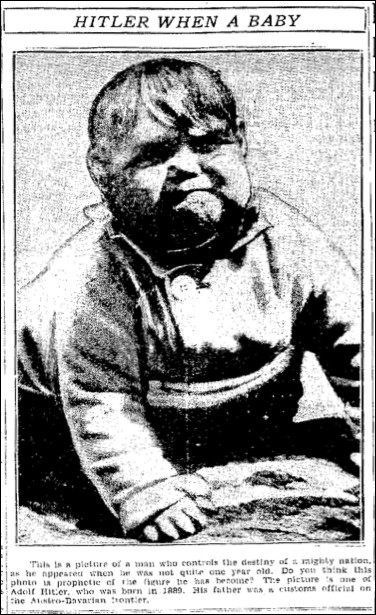
Winnipeg Free Press, October 25, 1933
However, the baby picture didn't actually show the infant führer. The German consulate in Chicago wrote a letter to the Chicago Tribune correcting the error:

The real baby Adolf
Subsequent investigation by Acme Newspictures found that the Baby Adolf picture had come from the syndicate's London bureau, which, in turn, received it from Austria, Hitler's native country. Beyond that, the trail went cold. The identity of the hoaxer was unknown.
Mrs. Harriet Downs of Ohio happened to see the picture in a magazine and immediately recognized it as her son (by a former marriage), John May Warren. However, in the original image her son looked cute, bright, and wholesome. Someone had darkened the shadows around the child's face to give him a more sinister look.
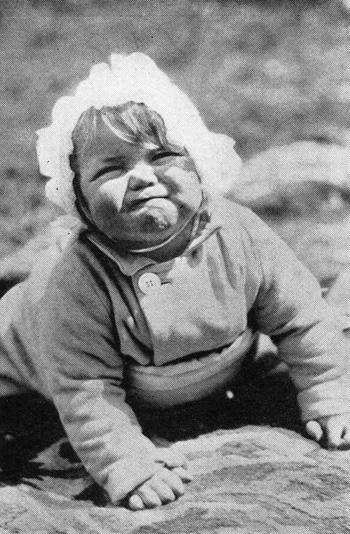
Mrs. Downs contacted Acme Newspictures, who, in May 1938, issued a correction:
It still remained a mystery how John Warren's picture had ended up in Austria in the hands of a photo forger. That mystery has never been solved.
Tragically, John Warren died a few months after Acme issued its correction, when he fell from his bicycle and pierced his heart on a milk bottle.
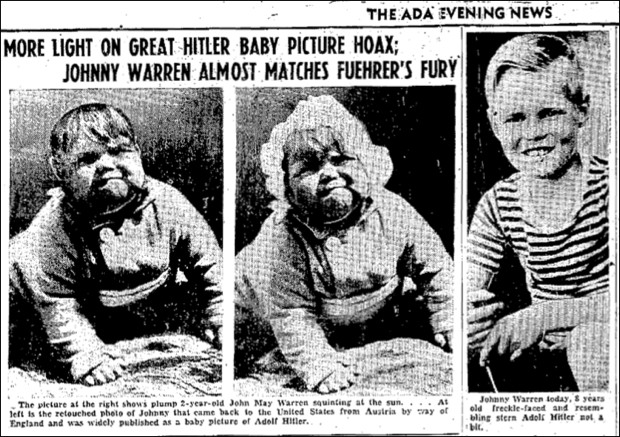
Ada Evening News, May 13, 1938

The image was distributed by Acme Newspictures, Inc. and appeared in many newspapers and magazines. For instance, in October 1933 the Chicago Tribune printed it alongside a photo of the adult Hitler addressing 500,000 farmers and storm troopers, above the caption, "Two Pictures of Hitler." The Winnipeg Free Press ran the picture with the caption: "This is a picture of a man who controls the destiny of a mighty nation, as he appeared when he was not quite one year old. Do you think this photo is prophetic of the figure he has become? The picture is one of Adolf Hitler, who was born in 1889."

Winnipeg Free Press, October 25, 1933
However, the baby picture didn't actually show the infant führer. The German consulate in Chicago wrote a letter to the Chicago Tribune correcting the error:
In the Rotogravure section of the... Tribune of October 22, 1933 there appeared under the title 'Two pictures of Hitler' two photographs, one purporting to be a 'baby picture' of the present Chancellor of the German Reich... and the other showing the Chancellor addressing 500,000 farmers and storm troopers... The alleged 'baby picture'... was sent to the Foreign Office in Berlin and the Consulate General was recently advised that the photograph stated to be a 'baby picture' of the Reichs-Chancellor is a falsification. The Foreign Office in Berlin transmitted at the same time a copy of an authentic photograph of Reichs-Chancellor Adolf Hitler before he attained the age of one year with the request to bring the matter to your attention.

The real baby Adolf
Subsequent investigation by Acme Newspictures found that the Baby Adolf picture had come from the syndicate's London bureau, which, in turn, received it from Austria, Hitler's native country. Beyond that, the trail went cold. The identity of the hoaxer was unknown.
The Baby Identified
If the baby in the picture wasn't Adolf Hitler, then who was it? The answer to this question wasn't known until 1938. Mrs. Harriet Downs of Ohio happened to see the picture in a magazine and immediately recognized it as her son (by a former marriage), John May Warren. However, in the original image her son looked cute, bright, and wholesome. Someone had darkened the shadows around the child's face to give him a more sinister look.

Mrs. Downs contacted Acme Newspictures, who, in May 1938, issued a correction:
"The picture purporting to be that of Baby Hitler actually was a photograph of 2-year-old John May Warren, then of Westport, Conn., now residing in Lakewood, Ohio... Recently, Mrs. Harriet M.W. Downs noticed the false picture reprinted in a magazine and recognized it as a photo of her son by a former marriage, John May Warren, now grown into a strapping, freckled schoolboy of eight years, who looks nothing like Hitler. The original snapshot had been retouched so that a baby cap was painted out and the features distorted so that what had been a babyish squint in the true picture appeared as a particularly unpleasant grimace."
It still remained a mystery how John Warren's picture had ended up in Austria in the hands of a photo forger. That mystery has never been solved.
Tragically, John Warren died a few months after Acme issued its correction, when he fell from his bicycle and pierced his heart on a milk bottle.

Ada Evening News, May 13, 1938
References:
- (October 22, 1933). Chicago Daily Tribune.
- "Hitler when a baby." (October 26, 1933). Winnipeg Free Press.
- "Baby Adolf." (March 5, 1934). Time Magazine.
- "More light on great hitler baby picture hoax; Johnny Warren almost matches fuehrer's fury." (May 13, 1938). The Ada Evening News.
- "Died. John May Warren, 8." (August 8, 1938). Time Magazine.
- MacDougall, Curtis. (1958). Hoaxes. Dover Publications. p.193.
Lung-Powered Flying Machine
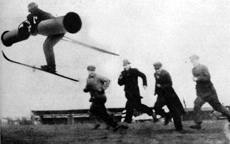
Status: April Fool's joke
Date: April 1, 1934
Date: April 1, 1934
The Berliner Illustrirte Zeitung ran this photo in its April Fool's Day edition to illustrate a (joke) story about a flying machine powered by the breath from a man's lungs. The man demonstrating the machine was identified as Erich Koycher. International News Photo, believing the story to be true, distributed the photo to its American subscribers. As a consequence, it subsequently appeared as factual news in many American papers, including in the New York Times. "Koycher" was a pun on the German word "keuchen," meaning to wheeze or gasp for breath.
References:
Man Flies By Own Lung Power, April Fool's Day Archive.
Man Flies By Own Lung Power, April Fool's Day Archive.
Technique: Composite Images. Time Period: 1920-1939.
Themes: Humor, April Fool’s Day, Planes, Technology, viral images,.
Themes: Humor, April Fool’s Day, Planes, Technology, viral images,.
The Surgeon’s Photo
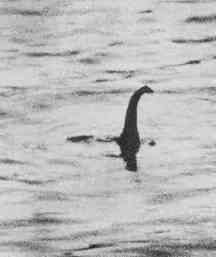 |
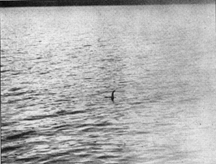 |
Status: Staged with a model
Date: April 1934
Date: April 1934
The modern history of the Loch Ness Monster began in 1933 when a new road was completed along the northern shore of Loch Ness, providing easy access to unobstructed views of the water. Soon after this, a couple spotted an "enormous animal" in the Loch. The Inverness Courier wrote up their sighting, describing what they saw as a "monster." Intense media interest followed, and thus was born the modern legend of the Loch Ness Monster.
Later that same year, the Daily Mail, taking advantage of the Nessie craze, hired a famous big-game hunter, Marmaduke Wetherell, to travel up to the Loch to investigate the sightings and to find the monster, if he could. Although he found no monster, in December 1933 he did locate what appeared to be its tracks—enormous footprints on the shore of the Loch leading into the water. Unfortunately, when researchers from the Natural History Museum examined the tracks, they determined they had been made with a dried hippo's foot, of the kind that were popularly used as umbrella stands. Humiliated, Wetherell retreated from public view.
But a few months later, the Loch Ness monster again made headlines when a highly respected British surgeon, Colonel Robert Wilson, came forward with a picture (top) that appeared to show a sea serpent rising out of the water of the Loch.
Wilson claimed he took the photograph early in the morning on April 19, 1934, while driving along the northern shore of Loch Ness. He said he noticed something moving in the water and stopped his car to take a photo. For decades this photo was considered to be the best evidence of the existence of a sea monster in the Loch. But Wilson himself refused to have his name associated with it. Therefore it came to be known simply as "The Surgeon's Photo."
For years skeptics were sure that the photo was somehow a hoax. But no rigorous studies of the image were conducted until 1984 when Stewart Campbell analyzed the photo in a 1984 article in the British Journal of Photography. Campbell concluded that the object in the water could only have been two or three feet long, at most, and that it probably was an otter or a marine bird. He suggested it was likely that Wilson knew this to be the case.
But as it turned out, Campbell was wrong. The object in the water was not a form of marine life. It was a toy submarine outfitted with a sea-serpent head. This was revealed in 1994 when Christian Spurling, before his death at the age of 90, confessed to his involvement in a plot to create the famous Surgeon's Photo, a plot that involved both Marmaduke Wetherell and Colonel Wilson.
According to Spurling, he had been approached by Wetherell (his stepfather) who wanted him to make a convincing serpent model. Spurling did this, and this model was then photographed in Loch Ness. The picture was then given to Wilson, whose job it was to serve as a credible front-man for the hoax.
Apparently Wetherell's motive was revenge, since he was still smarting from his humiliation over the hippo-foot tracks. "We'll give them their monster," his son later remembered him saying.
In the original version of the image (bottom) the diminutive size of the Nessie model in relationship to the Loch can be seen. (The dark band along the top of the picture is the opposite side of the Loch.) The image given to the media was cropped to hide this perspective, making the "monster" appear larger than it actually was.
Later that same year, the Daily Mail, taking advantage of the Nessie craze, hired a famous big-game hunter, Marmaduke Wetherell, to travel up to the Loch to investigate the sightings and to find the monster, if he could. Although he found no monster, in December 1933 he did locate what appeared to be its tracks—enormous footprints on the shore of the Loch leading into the water. Unfortunately, when researchers from the Natural History Museum examined the tracks, they determined they had been made with a dried hippo's foot, of the kind that were popularly used as umbrella stands. Humiliated, Wetherell retreated from public view.
But a few months later, the Loch Ness monster again made headlines when a highly respected British surgeon, Colonel Robert Wilson, came forward with a picture (top) that appeared to show a sea serpent rising out of the water of the Loch.
Wilson claimed he took the photograph early in the morning on April 19, 1934, while driving along the northern shore of Loch Ness. He said he noticed something moving in the water and stopped his car to take a photo. For decades this photo was considered to be the best evidence of the existence of a sea monster in the Loch. But Wilson himself refused to have his name associated with it. Therefore it came to be known simply as "The Surgeon's Photo."
For years skeptics were sure that the photo was somehow a hoax. But no rigorous studies of the image were conducted until 1984 when Stewart Campbell analyzed the photo in a 1984 article in the British Journal of Photography. Campbell concluded that the object in the water could only have been two or three feet long, at most, and that it probably was an otter or a marine bird. He suggested it was likely that Wilson knew this to be the case.
But as it turned out, Campbell was wrong. The object in the water was not a form of marine life. It was a toy submarine outfitted with a sea-serpent head. This was revealed in 1994 when Christian Spurling, before his death at the age of 90, confessed to his involvement in a plot to create the famous Surgeon's Photo, a plot that involved both Marmaduke Wetherell and Colonel Wilson.
According to Spurling, he had been approached by Wetherell (his stepfather) who wanted him to make a convincing serpent model. Spurling did this, and this model was then photographed in Loch Ness. The picture was then given to Wilson, whose job it was to serve as a credible front-man for the hoax.
Apparently Wetherell's motive was revenge, since he was still smarting from his humiliation over the hippo-foot tracks. "We'll give them their monster," his son later remembered him saying.
In the original version of the image (bottom) the diminutive size of the Nessie model in relationship to the Loch can be seen. (The dark band along the top of the picture is the opposite side of the Loch.) The image given to the media was cropped to hide this perspective, making the "monster" appear larger than it actually was.
References:
Martin, D. & Boyd, A. (1999). Nessie: The Surgeon's Photograph Exposed. Thorne Printing.
Martin, D. & Boyd, A. (1999). Nessie: The Surgeon's Photograph Exposed. Thorne Printing.
Technique: Cropping, Staged Scene, Models and Cutouts. Time Period: 1920-1939.
Themes: Paranormal, Cryptozoology,.
Themes: Paranormal, Cryptozoology,.
Whopper Hoppers
 |
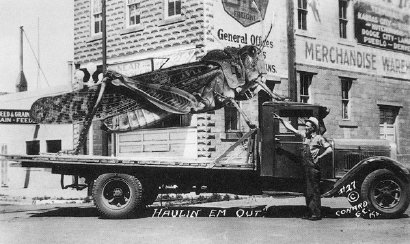 |
Status: Either staged or composites.
Date: circa 1935
Date: circa 1935
Giant grasshoppers were popular subjects for tall-tale postcards, particularly in the Great Plains during the 1930s where grasshoppers were a common pest.
The top photo shows a scene captured by an unknown photographer near Mitchell, South Dakota. Three men struggle to subdue "the largest grasshopper in existence." The "whopper hopper" appears to be a wooden model.
The bottom image was created by Frank D. "Pop" Conard of Garden City, Kansas. He was considered to be the master of the 'whopper hopper' genre of postcards. In this image by Conard, a farmer hauls out a particularly large hopper specimen.
The top photo shows a scene captured by an unknown photographer near Mitchell, South Dakota. Three men struggle to subdue "the largest grasshopper in existence." The "whopper hopper" appears to be a wooden model.
The bottom image was created by Frank D. "Pop" Conard of Garden City, Kansas. He was considered to be the master of the 'whopper hopper' genre of postcards. In this image by Conard, a farmer hauls out a particularly large hopper specimen.
References:
• Rubin, C.E. & Williams, M. (1990). Larger Than Life: The American Tall-Tale Postcard, 1905-1915. Abbeville Press.
• Rubin, C.E. & Williams, M. (1990). Larger Than Life: The American Tall-Tale Postcard, 1905-1915. Abbeville Press.
Technique: Staged Scene, Models and Cutouts. Time Period: 1920-1939.
Themes: Animals, Very Large Animals, Humor, Tall-Tale Postcards,.
Themes: Animals, Very Large Animals, Humor, Tall-Tale Postcards,.
The Perambulating Skull
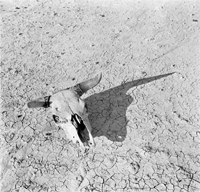 |
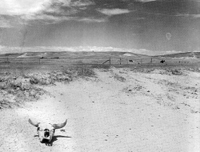 |
 |
Status: Staged
Date: May 1936
Date: May 1936
Twenty-two-year-old Arthur Rothstein took these photos while on assignment for the Resettlement Administration in South Dakota. His task was to document drought conditions there. But when the top photo was released to the media in August, 1936, coinciding with a trip by President Roosevelt to the Great Plains, it generated enormous controversy.
Republican papers, led by the Fargo Forum, argued that the photo amounted to government propaganda designed to create the appearance of drought conditions for political purposes. In reality, the Fargo Forum insisted, there had been no drought. The photo simply showed, it explained, an alkali flat, similar to ones that could be found in "Maryland, Pennsylvania, Indiana. Wherever one chooses." The paper also called the skull "a movable prop, which comes in handy for photographers who want to touch up their pictures with a bit of the grisly."
Subsequent investigation turned up the other pictures, revealing that Rothstein had indeed moved the skull around. Republican critics made it sound as if Rothstein had traveled the country with the steer's skull in his suitcase, but Rothstein insisted he had moved the skull no more than ten feet from where he had originally found it. Nevertheless, the controversy hung over Rothstein for the remainder of his career. Critics mockingly referred to the cow's head as the "perambulating skull."
Republican papers, led by the Fargo Forum, argued that the photo amounted to government propaganda designed to create the appearance of drought conditions for political purposes. In reality, the Fargo Forum insisted, there had been no drought. The photo simply showed, it explained, an alkali flat, similar to ones that could be found in "Maryland, Pennsylvania, Indiana. Wherever one chooses." The paper also called the skull "a movable prop, which comes in handy for photographers who want to touch up their pictures with a bit of the grisly."
Subsequent investigation turned up the other pictures, revealing that Rothstein had indeed moved the skull around. Republican critics made it sound as if Rothstein had traveled the country with the steer's skull in his suitcase, but Rothstein insisted he had moved the skull no more than ten feet from where he had originally found it. Nevertheless, the controversy hung over Rothstein for the remainder of his career. Critics mockingly referred to the cow's head as the "perambulating skull."
References:
Curtis, J. (1989). Mind's Eye, Mind's Truth: FSA Photography Reconsidered. Temple University Press.
Curtis, J. (1989). Mind's Eye, Mind's Truth: FSA Photography Reconsidered. Temple University Press.
Technique: Staged Scene, Movable Prop. Time Period: 1920-1939.
Themes: Landscapes, Photojournalism, Politics,.
Themes: Landscapes, Photojournalism, Politics,.
The Brown Lady of Raynham
Status: Probably a double exposure
Date: September 19, 1936
Date: September 19, 1936
This is one of the most famous ghost photos of all time. It supposedly shows the "Brown Lady" who haunts Raynham Hall in Norfolk, England.
The image was taken by Captain Provand and Indre Shira (a pseudonym), two photographers on assignment for Country Life magazine. According to their later testimony, the pair saw an ethereal form descending the staircase and quickly snapped a picture.
Skeptics argue that the photo does not show a ghost, but rather was the result of mundane causes such as camera vibration, afternoon light from the window above the stairs catching the lens of the camera, and double exposure. What is not known is whether these effects were produced purposefully, or if they were the accidental result of a faulty camera.
The image was taken by Captain Provand and Indre Shira (a pseudonym), two photographers on assignment for Country Life magazine. According to their later testimony, the pair saw an ethereal form descending the staircase and quickly snapped a picture.
Skeptics argue that the photo does not show a ghost, but rather was the result of mundane causes such as camera vibration, afternoon light from the window above the stairs catching the lens of the camera, and double exposure. What is not known is whether these effects were produced purposefully, or if they were the accidental result of a faulty camera.
References:
Murdie, A. (Sep 2006). The Brown Lady of Raynham Hall. Fortean Times.
Murdie, A. (Sep 2006). The Brown Lady of Raynham Hall. Fortean Times.
Biggest Fish Ever Caught
Status:
Date: 1939
Date: 1939
The Commissar Vanishes
Status: Fake (deleted person)
Date: ca. 1940
Date: ca. 1940
During the 1930s Nikolai Yezhov was one of Stalin's most powerful officials. In 1936 he was appointed People's Commissar for Internal Affairs, in which position he led brutal purges, causing him to be widely feared. Yezhov can be seen in the top photo (undated, but probably from the mid 1930s), strolling along the Moscow-Volga Canal with Stalin, Defense Commissar Kliment Voroshilov and Premier Vyacheslav Molotov. Yezhov is on the far right beside Stalin.
But Yezhov's violent methods eventually provoked a backlash, and in the late 1930s he fell out of favor. He was arrested in 1939 and executed in February 1940. In a subsequently released version of the Moscow-Volga canal photo (bottom), Yezhov was no longer present. He had been removed by political censors.
This pair of images gave its name to The Commissar Vanishes, a book (and later museum exhibit) by David King that explores the history of Soviet photo falsification. It has become one of the most famous examples of how totalitarian regimes often doctor photos in an attempt to rewrite history.
But Yezhov's violent methods eventually provoked a backlash, and in the late 1930s he fell out of favor. He was arrested in 1939 and executed in February 1940. In a subsequently released version of the Moscow-Volga canal photo (bottom), Yezhov was no longer present. He had been removed by political censors.
This pair of images gave its name to The Commissar Vanishes, a book (and later museum exhibit) by David King that explores the history of Soviet photo falsification. It has become one of the most famous examples of how totalitarian regimes often doctor photos in an attempt to rewrite history.
The Nazi Air Marker Hoax
Status: Real pictures, falsely captioned
Date: August 1942
Date: August 1942
On August 10, 1942, the U.S. Army's public-relations office released a statement informing the press that fliers for the First Ground Air Support Command had discovered "secret markers" in rural areas of the east coast. These markers, apparently placed by fifth-columnists, appeared innocent from the ground but acquired a sinister meaning when viewed from the air. From an aerial perspective they formed arrows "aimed directly at airplane factories and airfields." The purpose of these markers, Army intelligence believed, was to guide Nazi bombers straight toward targets of military significance.
The Army simultaneously released three pictures showing these markers. One marker appeared in a tilled field. The fallow land was darker than the tilled sections and approximated the outline of an arrow. A second marker was formed by sacks arranged in the shape of the number "9". The tail of the 9 pointed toward a nearby airplane factory. The third marker was in a woodland area where a lane led to a V-shaped clearing.
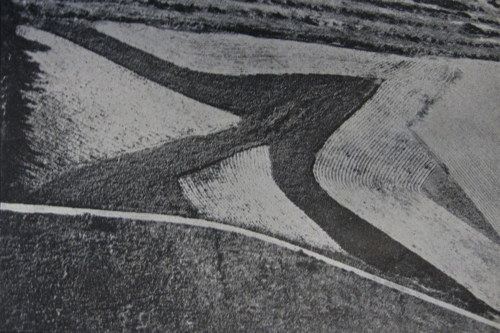
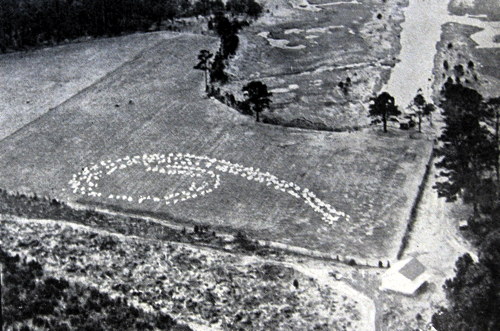
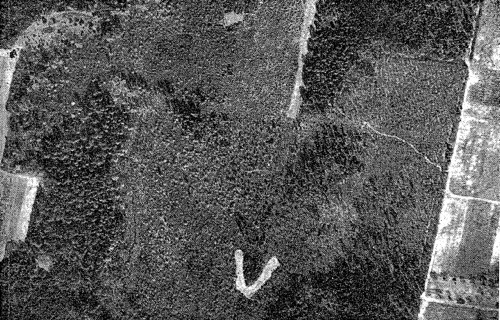
Col. Dache M. Reeves said that the markers had been investigated by intelligence officers of the First Air Force, and that they had been eradicated and there was "proper action taken." The exact location of the markers was not given. They were only described as being in the eastern part of the United States. They were cited as being "clear instances of how enemy agent or sympathizers sowed into peaceful farmlands potential devices to aid destruction."
The discovery of the air markers received widespread press coverage, making front-page headlines in all the major papers throughout the United States, including the New York Times, Washington Post, and Los Angeles Times. Editorials warned of the need to be on the alert for treachery at home.

An O-47, the type of observation plane that would have been used to spot the markers.
But within a day the markers went from being a menace to an object of mockery.
The Washington Star, curious to learn more, made some inquiries and immediately discovered that the markers had been investigated by Army officials months before and had been determined to have no military significance. Even worse, as the Star noted, "the same story, with an alteration here and there — and sans pictures, was distributed from the same source in June, and published in Sunday feature sections. At that time, however, the pictures of the 'markers' were withheld as 'military secrets.'"
The number 9 had been made by fertilizer sacks dropped from a moving truck on the farm of C. Russell Bull at Kiptopeke, Virginia. Mr. Bull served as senior air raid warden for his region. Mrs. Bull was quoted as saying that military officials had visited their farm in March and called attention to the figuration of the fertilizer sacks, but had left after the layout was rearranged by her husband. She also noted that, "We've been drying bags that way for years. They are just thrown off a moving truck and it was only a coincidence that they happened to fall that way."
The plowed-field marker was located on the farm of Thomas Kane, near Freehold, N.J. It had been created four years earlier under direct supervision of the soil-erosion bureau of the Department of Agriculture.
The V-shaped clearing was a feeding ground for birds near Haleyville, N.J. It was one of approximately nine hundred feeding grounds created by the New Jersey Fish and Game Commission in 1937.
The Washington Star concluded that it and other newspapers "were the victims of over-zealous army press-agentry, and as a result, participated unwittingly in what appears to be the great air marker hoax."
The Army press officer found to be responsible for the release of the statement was Major Lynn Farnol. Farnol was a movie press agent who had been commissioned into uniform to serve as a public relations officer. However, he was still running his own business, and apparently wanted good relations with the press. Therefore he sent them what he felt was a good story.
Farnol noted that the press release had been approved by the War Department's information staff. However, it turned out that the information staff had not checked the statement for accuracy. They had merely checked to determine if it violated censorship rules. Seeing that it did not, they gave it their okay.
The Army later announced that the press office would be reorganized so that mistakes such as the "air marker hoax" would not be repeated in the future.

By coincidence, the comic strip Tim Tyler's Luck had featured an "air marker"
a week before the story of the Nazi air markers broke.
The Army simultaneously released three pictures showing these markers. One marker appeared in a tilled field. The fallow land was darker than the tilled sections and approximated the outline of an arrow. A second marker was formed by sacks arranged in the shape of the number "9". The tail of the 9 pointed toward a nearby airplane factory. The third marker was in a woodland area where a lane led to a V-shaped clearing.



Col. Dache M. Reeves said that the markers had been investigated by intelligence officers of the First Air Force, and that they had been eradicated and there was "proper action taken." The exact location of the markers was not given. They were only described as being in the eastern part of the United States. They were cited as being "clear instances of how enemy agent or sympathizers sowed into peaceful farmlands potential devices to aid destruction."
The discovery of the air markers received widespread press coverage, making front-page headlines in all the major papers throughout the United States, including the New York Times, Washington Post, and Los Angeles Times. Editorials warned of the need to be on the alert for treachery at home.

An O-47, the type of observation plane that would have been used to spot the markers.
But within a day the markers went from being a menace to an object of mockery.
The Washington Star, curious to learn more, made some inquiries and immediately discovered that the markers had been investigated by Army officials months before and had been determined to have no military significance. Even worse, as the Star noted, "the same story, with an alteration here and there — and sans pictures, was distributed from the same source in June, and published in Sunday feature sections. At that time, however, the pictures of the 'markers' were withheld as 'military secrets.'"
The Origin of the Markers
Far from being sinister signs left by Nazi sympathizers, the markers turned out to have been entirely innocent patterns on the ground — in two cases made under the direction of the U.S. Government itself.The number 9 had been made by fertilizer sacks dropped from a moving truck on the farm of C. Russell Bull at Kiptopeke, Virginia. Mr. Bull served as senior air raid warden for his region. Mrs. Bull was quoted as saying that military officials had visited their farm in March and called attention to the figuration of the fertilizer sacks, but had left after the layout was rearranged by her husband. She also noted that, "We've been drying bags that way for years. They are just thrown off a moving truck and it was only a coincidence that they happened to fall that way."
The plowed-field marker was located on the farm of Thomas Kane, near Freehold, N.J. It had been created four years earlier under direct supervision of the soil-erosion bureau of the Department of Agriculture.
The V-shaped clearing was a feeding ground for birds near Haleyville, N.J. It was one of approximately nine hundred feeding grounds created by the New Jersey Fish and Game Commission in 1937.
The Washington Star concluded that it and other newspapers "were the victims of over-zealous army press-agentry, and as a result, participated unwittingly in what appears to be the great air marker hoax."
Blame
The war department, embarrassed by the revelation, admitted that the story "may be untrue." The Army press officer found to be responsible for the release of the statement was Major Lynn Farnol. Farnol was a movie press agent who had been commissioned into uniform to serve as a public relations officer. However, he was still running his own business, and apparently wanted good relations with the press. Therefore he sent them what he felt was a good story.
Farnol noted that the press release had been approved by the War Department's information staff. However, it turned out that the information staff had not checked the statement for accuracy. They had merely checked to determine if it violated censorship rules. Seeing that it did not, they gave it their okay.
The Army later announced that the press office would be reorganized so that mistakes such as the "air marker hoax" would not be repeated in the future.

By coincidence, the comic strip Tim Tyler's Luck had featured an "air marker"
a week before the story of the Nazi air markers broke.
References:
- Thompson, Dorothy. (Aug 18, 1942). "It can't go on like this." The Daily Gleaner.
- "Story on guideposts believed to be untrue." (Aug 11, 1942). The Sheboygan Press.
- "Destroy markers made for enemy." (Aug 10, 1942). Edwardsville Intelligencer.
- "Army reshuffles its publicity but a boner gets under wire." (Aug 24, 1942). Newsweek.
- "Air-Marker Fraud". (Aug 24, 1942). Time.
